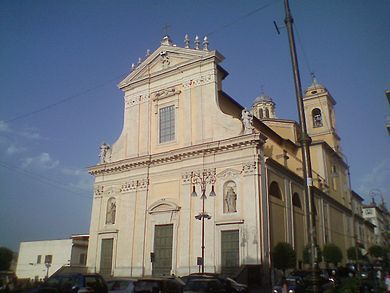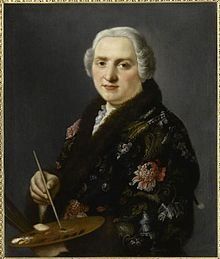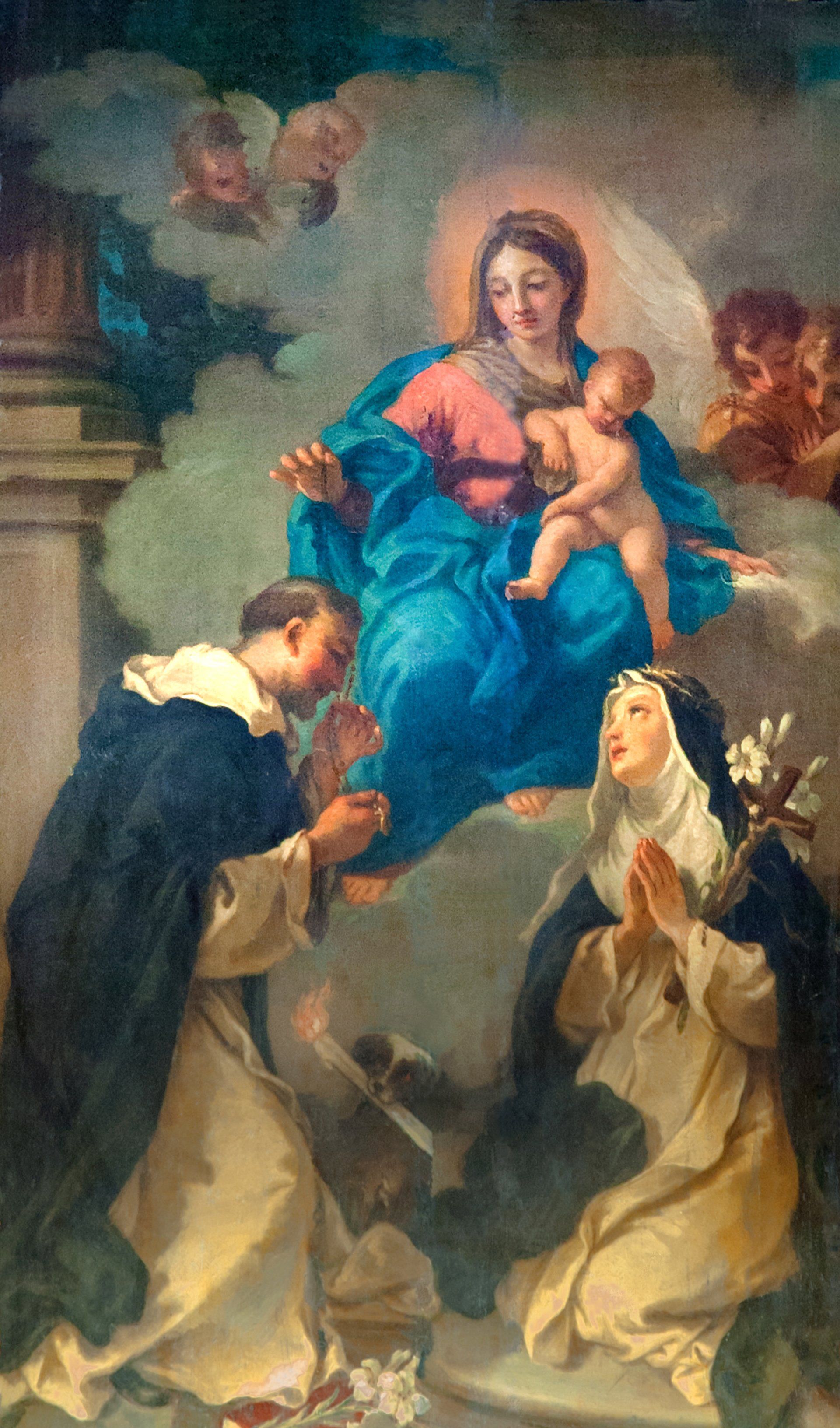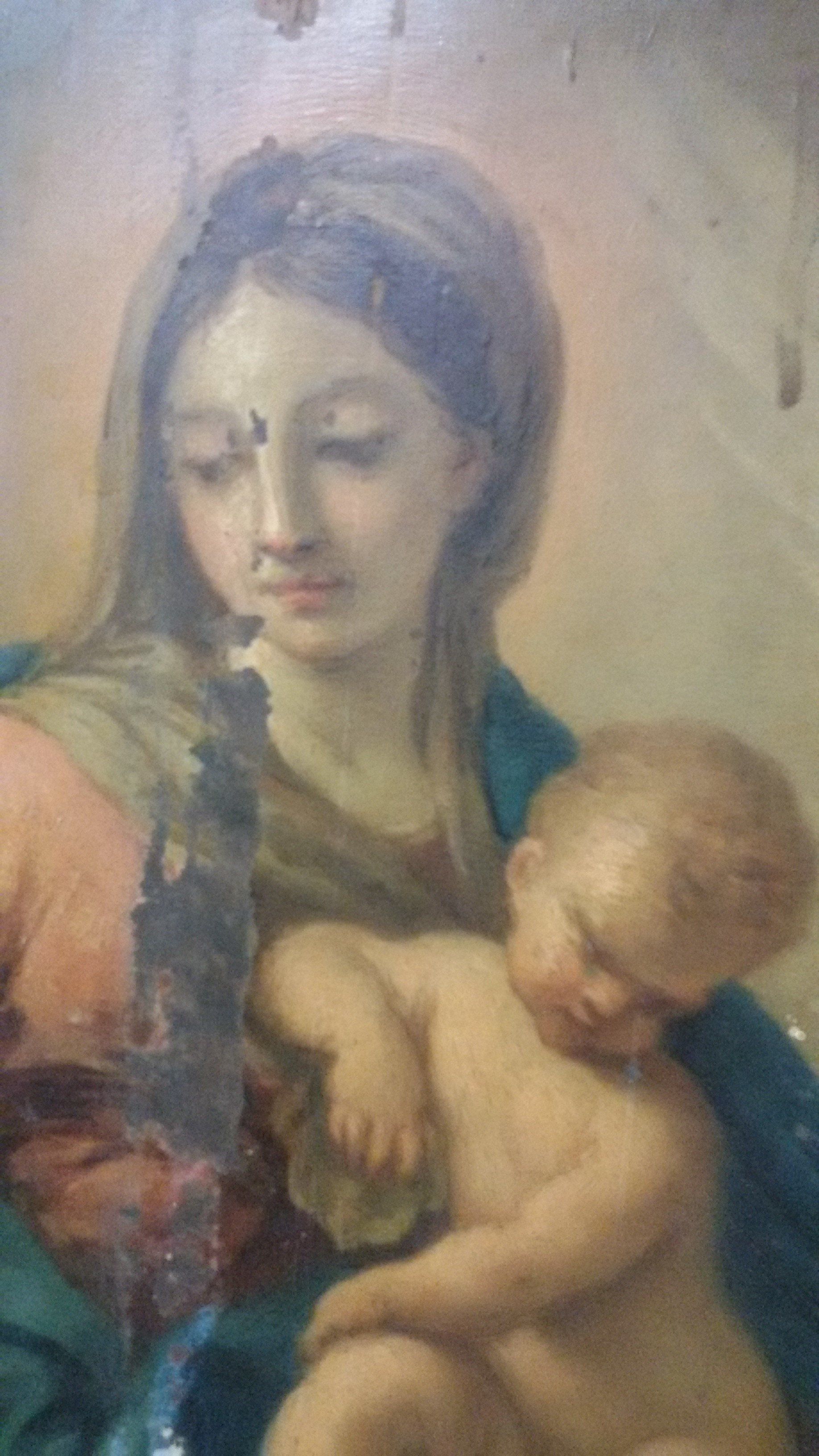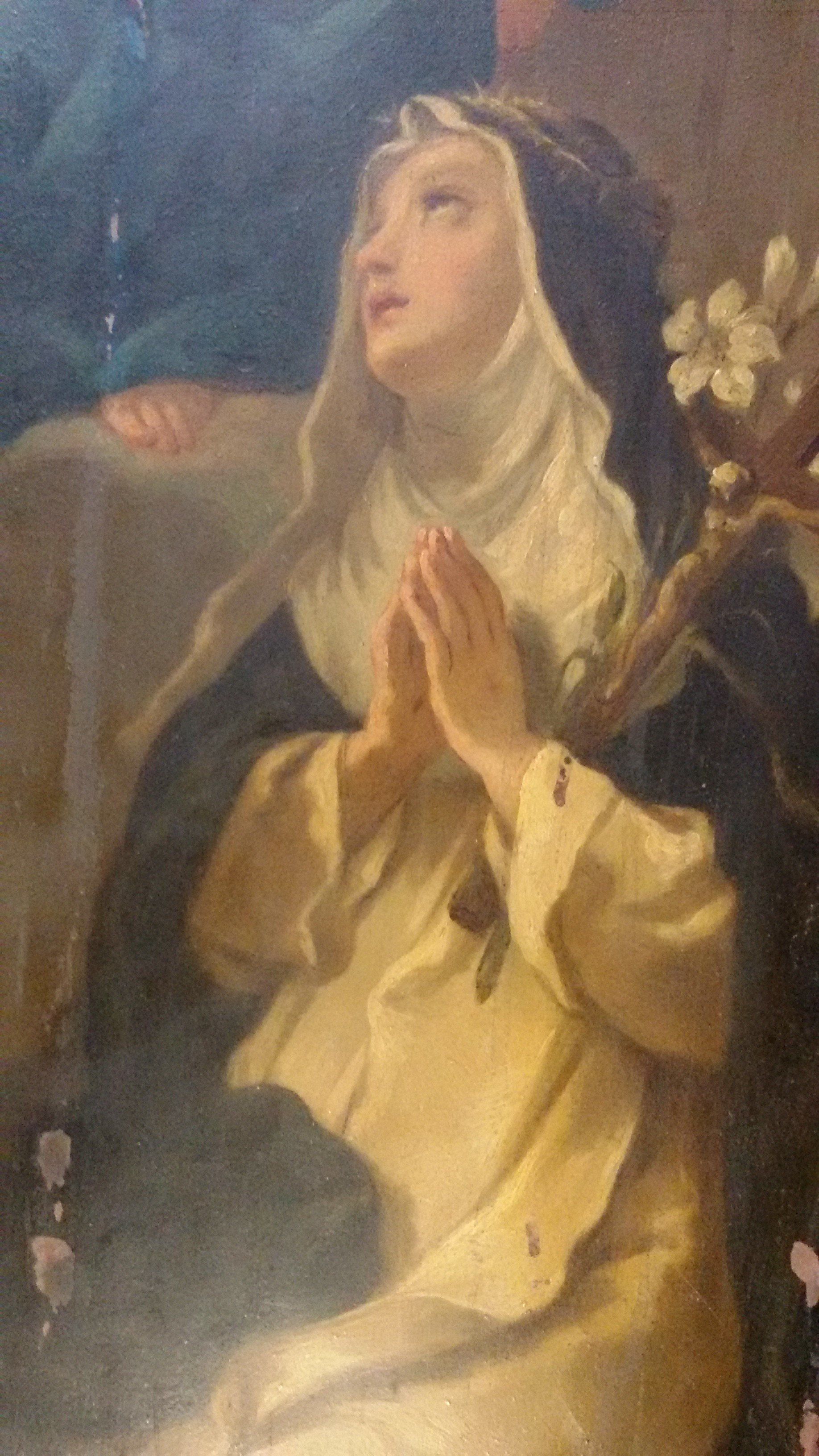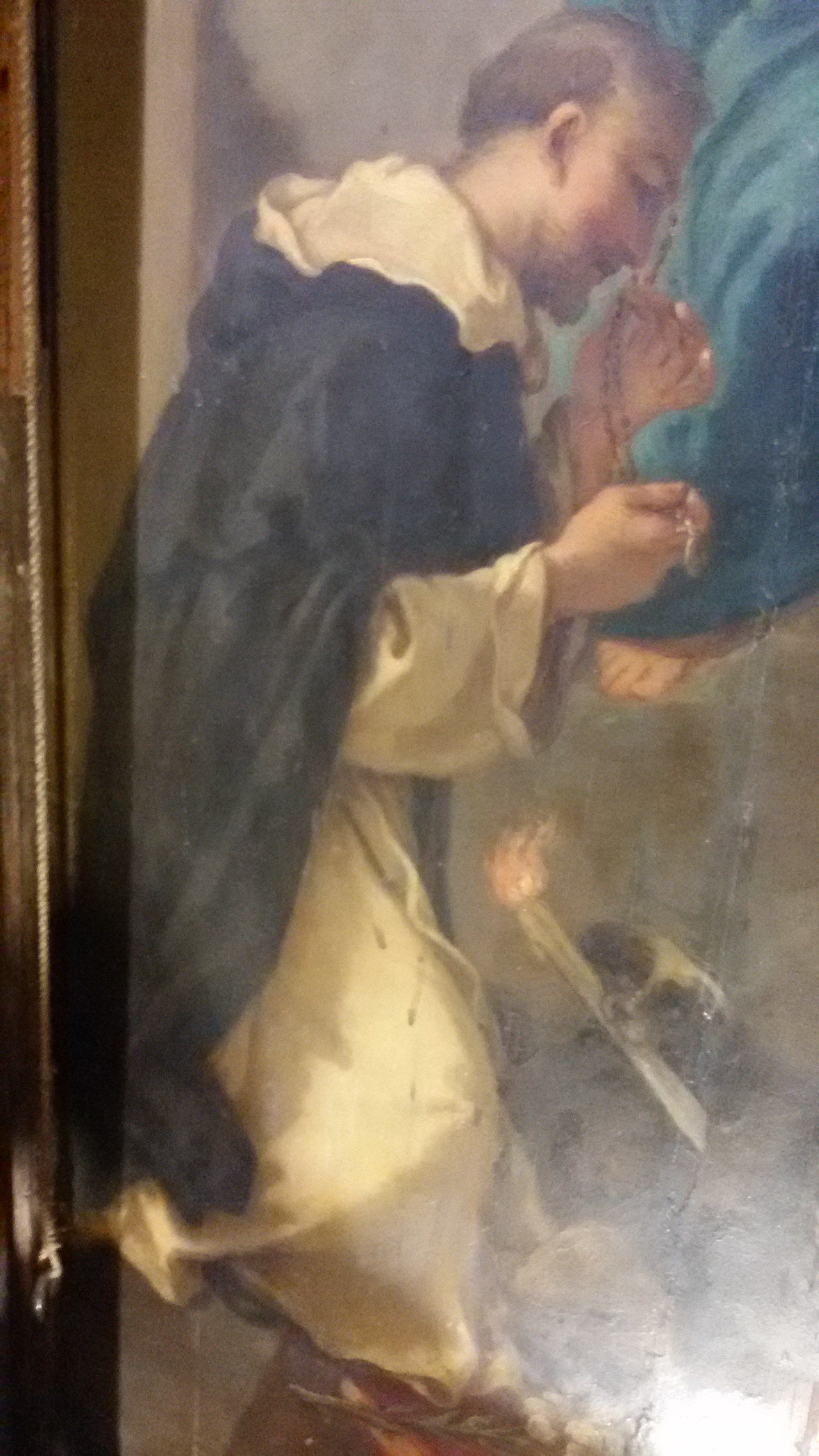The collegiate basilica of San Barnaba Apostolo is the main place of Catholic worship in the city of Marino in the province of Rome, in the suburb of Albano.
THE BASILICA SAN BARNABA APOSTOLO
A rediscovered Madonna The Virgin of the Holy Rosary by Sebastiano Ceccarini copied by Passeri. Despite the very serious theft of works of art in 1984, a monumental church full of works of art, such as the collegiate abbey basilica of San Barnaba di Marino, it never ceases to amaze with continuous discoveries. Recent are the important attributions, thanks to the art historian arch. Francesco Petrucci, to Luigi Garzi of the painting of the Madonna del Carmelo on the altar of the right arm of the transept, to Giuseppe Ghezzi of the Madonna Assunta in Cielo at the beginning of the left aisle, to Francesco Rosa del Trapasso di San Francesco Saverio (1680) to the beginning of the right aisle, in Giacinto Campana with interventions by Guercino del Martirio di San Bartolomeo on the altar of the left arm of the transept. An extraordinary discovery recently took place, by Msgr. Pietro Massari, abbot pastor of the cathedral of Marino, as casual and unexpected as I dare to say "prodigious". It is an oil painting on a copper plate, which represents the Madonna of the Holy Rosary, according to a usual iconography: the Virgin of the Rosary, seated on a throne of clouds, is at the center of the composition with the Child in her arms and, on its sides, the two main Dominican saints: St. Dominic on the left, while receiving the Rosary crown and St. Catherine on the right, who with joined hands turns her gaze to the Madonna. it owes to a specific papal bull of 1569 of Saint Pius V, a Dominican monk, particularly devoted to this practice. The Pope promoted a "Rosary Crusade" to combat heresies in the north, in Europe, and the Islamic threats of the Turks in the south. He promoted a Holy League among Catholic nations, which culminated with the naval battle of Lepanto on 7 October 1571. He wanted this war effort to be placed under the protection of the Virgin of the Rosary, who appeared to him in a vision that same day to announce the victory. . Thanks to the intercession obtained by the Madonna del Rosario, the pope instituted the thanksgiving feast in honor of Santa Maria della Vittoria on 17 March 1572. This feast was then moved from March to the first Sunday in October with the reform of the calendar promulgated by the successor Pope Gregory XIII. Marino is particularly linked to the memory of Lepanto, for being its lord Marcantonio Colonna captain of the papal fleet personally appointed by Pope Pius V. From the successful enterprise derived honor and prestige for the entire Colonna family, which in many places wanted to perpetuate the success of the enterprise. For this reason the celebratory Fountain of the Moors was erected in 1632 and then in 1675 the monastery of the Dominican nuns was built by Sister Maria Isabella Colonna with the beautiful 1712 church of Giuseppe Sardi dedicated to the Virgin of the Holy Rosary. In this regard, the connection of the Dominican nuns of Marino with the sacred places of the area of Rome dominated by the Colonna family (Torre delle Milizie, Palazzo Colonna etc.), but above all with the convent and the church of San Domenico al Quirinale, should not be underestimated. , from which the Marinese nuns came, and then again with the nearby church of Santa Caterina in Magnanapoli (1641), where there are works by architects such as Vincenzo della Greca and some painters, who we find active in the basilica of Marino, such as Luigi Garzi and Giuseppe Passeri, to whose ambit the discovery painted on a copper plate can be traced back. It is no coincidence, therefore, that a chapel of the basilica of San Barnaba, the third of the right aisle, was dedicated to the Madonna del Ss. Rosario, where from the beginning, we believe, the work that we see on display today was placed. The basilica of San Barnaba, begun in 1640, was finished after fifteen years in 1655, but the internal works ended in 1662 and was consecrated only in 1713.The third chapel in the right aisle, completed in 1662, was dedicated to the Madonna del Ss. Rosario and since its establishment it was entrusted and kept by the homonymous brotherhood. On 10 December 1662, after a solemn procession, the panel painting of Mary Most Holy known as Madonna del Popolo, coming from the church of Santa Lucia, was placed on the altar. But the complete altar in all its decorative parts was consecrated on January 2, 1751. Here was placed the memory of Lepanto, a shield that is not Turkish, as is often repeated, but of a local Christian fighter, who placed it at the feet of the Madonna as an ex voto and then the fifteen ovals painted in fresco, framed in stucco on the vault and on the lateral pilasters, where the Mysteries of the Holy Rosary are represented. In this chapel the novenas of the Purification, of the Assumption, of the Nativity, of the Immaculate Conception of the Virgin, the Christmas novena of Jesus were made and the Holy Rosary was recited on Tuesdays, Saturdays and Sundays of each week of the 'year . For the rest of the time, the painted panel of the Madonna del Popolo stood out in the recess of the altarpiece. Hence the need to alternate the presence of the two sacred images with the veneration of the people, by means of a device operated at the base of the altar. Starting from the end of the works on the chapel, it is possible to think about the possible author of the painting on display today. Meanwhile, it must be said that this one by Marino appears in all respects not only for the subject, but also for the manufacture of the oil painting on canvas by Giuseppe Passeri (Rome, 1654-1714) placed on the altar of the Bonanni chapel, third on the left of the church of Santa Caterina in Magnanapoli in Rome entitled Madonna with Child, St. Dominic and St. Catherine, of which there is more than one preparatory drawing. Therefore our painting by Marino is a replica, or a beautiful copy of the Roman painting, according to the aforementioned Francesco Petrucci, and must be after 1703, the date of execution of the works by Passeri in Santa Caterina in Magnanapoli. As for Giuseppe Passeri we know that he learned the art of painting in the workshop of his uncle painter and historian Giovanni Battista Passeri, but his teacher was Carlo Maratti, who initiated him to the study of the classics of the Renaissance: Raphael and Annibale Caracci, and of the Baroque. : Guido Reni and Nicolas Poussin. Now, if the altar of the chapel of the Holy Rosary was finished in its decorative parts in 1750, to be consecrated in January 1751, the copy cannot be attributed to Passeri, who in the meantime was died in 1714, unless he had previously built it with a view to being subsequently placed in San Barnaba. At the end of these conjectures, however, the twist came. Our friend Maurizio Canestri di Marino tells us that he has examined a document dating back to 1760, which he found years earlier in the church of the Ss. Trinità di Marino, in which he explicitly mentions, as the author of the Marinese copy of the Madonna del Ss. Rosario del Passeri, the artist Sebastiano Ceccarini da Fano (1703-1783), who in this case would also have been of mature age to carry out the execution of the painting on commission.Sebastiano Ceccarini had Guido Reni, Carlo Maratti and Domenichino as models as a guide Giuseppe Ghezzi and then his son Pier Leone. He worked in several Roman churches and in other cities of Italy. Among his many paintings there is also a Madonna del Rosario from 1760, a panel painting preserved in Saltara (a fraction of the Colli del Metauro municipality in the province of Pesaro and Urbino) in the sanctuary of the Madonna della Villa today relocated to the church of San Pietro Celestino From the document that has just been found, which resembles an inventory of assets, or rather an income book of the Confraternity, we come to know exactly the date and the author of our painting: «... there is the niche in the altar where the sacred and ancient image of the Holy Virgin with her Child is kept on the right hand as will be said below under the curtain and inside the sacred niche there is a large copper in which the Holy Virgin of the Rosary is painted with his Child, Saint Dominic and Saint Catherine of Siena painting by Sebastiano Ceccarini paid for said painting 10 scudi and all the copper weighs forty pounds paid 13 scudi all alms from benefactors made the painting on 27 May 1748 which ser ve to guard the sacred image ". The copper plate of" 40 pounds of weight "(this metal is used to bring out the brightness of the colors from a distance) with its application of oil paint was housed in a compartment behind the frame of the upper ancon. The slab is still hanging from a rope, such as to allow it to be lifted by hand and from the bottom of the altar, by means of a system of pulleys. Thus in a sort of "condominium of spaces" the painted slab rose from the darkness of the cavity, where it was found by Msgr. Pietro Massari, in the light of the chapel, in such a way that it covered the painted table of the Madonna del Popolo in the days when prayers were raised to the Madonna of the Rosary. There are too many fortuitous coincidences in this singular event. The image and the document, both casually and contextually returned to light, suggest that this beautiful portrait of the Madonna del Ss. Rosario has decided a good moment to be found for the renewed prayer of the Marines. Ugo Onorati
A rediscovered Madonna The Virgin of the Holy Rosary by Sebastiano Ceccarini copied by Passeri. Despite the very serious theft of works of art in 1984, a monumental church full of works of art, such as the collegiate abbey basilica of San Barnaba di Marino, it never ceases to amaze with continuous discoveries. Recent are the important attributions, thanks to the art historian arch. Francesco Petrucci, to Luigi Garzi of the painting of the Madonna del Carmelo on the altar of the right arm of the transept, to Giuseppe Ghezzi of the Madonna Assunta in Cielo at the beginning of the left aisle, to Francesco Rosa del Trapasso di San Francesco Saverio (1680) to the beginning of the right aisle, in Giacinto Campana with interventions by Guercino del Martirio di San Bartolomeo on the altar of the left arm of the transept. An extraordinary discovery recently took place, by Msgr. Pietro Massari, abbot pastor of the cathedral of Marino, as casual and unexpected as I dare to say "prodigious". It is an oil painting on a copper plate, which represents the Madonna of the Holy Rosary, according to a usual iconography: the Virgin of the Rosary, seated on a throne of clouds, is at the center of the composition with the Child in her arms and, on its sides, the two main Dominican saints: St. Dominic on the left, while receiving the Rosary crown and St. Catherine on the right, who with joined hands turns her gaze to the Madonna. it owes to a specific papal bull of 1569 of Saint Pius V, a Dominican monk, particularly devoted to this practice. The Pope promoted a "Rosary Crusade" to combat heresies in the north, in Europe, and the Islamic threats of the Turks in the south. He promoted a Holy League among Catholic nations, which culminated with the naval battle of Lepanto on 7 October 1571. He wanted this war effort to be placed under the protection of the Virgin of the Rosary, who appeared to him in a vision that same day to announce the victory. . Thanks to the intercession obtained by the Madonna del Rosario, the pope instituted the thanksgiving feast in honor of Santa Maria della Vittoria on 17 March 1572. This feast was then moved from March to the first Sunday in October with the reform of the calendar promulgated by the successor Pope Gregory XIII. Marino is particularly linked to the memory of Lepanto, for being its lord Marcantonio Colonna captain of the papal fleet personally appointed by Pope Pius V. From the successful enterprise derived honor and prestige for the entire Colonna family, which in many places wanted to perpetuate the success of the enterprise. For this reason the celebratory Fountain of the Moors was erected in 1632 and then in 1675 the monastery of the Dominican nuns was built by Sister Maria Isabella Colonna with the beautiful 1712 church of Giuseppe Sardi dedicated to the Virgin of the Holy Rosary. In this regard, the connection of the Dominican nuns of Marino with the sacred places of the area of Rome dominated by the Colonna family (Torre delle Milizie, Palazzo Colonna etc.), but above all with the convent and the church of San Domenico al Quirinale, should not be underestimated. , from which the Marinese nuns came, and then again with the nearby church of Santa Caterina in Magnanapoli (1641), where there are works by architects such as Vincenzo della Greca and some painters, who we find active in the basilica of Marino, such as Luigi Garzi and Giuseppe Passeri, to whose ambit the discovery painted on a copper plate can be traced back. It is no coincidence, therefore, that a chapel of the basilica of San Barnaba, the third of the right aisle, was dedicated to the Madonna del Ss. Rosario, where from the beginning, we believe, the work that we see on display today was placed. The basilica of San Barnaba, begun in 1640, was finished after fifteen years in 1655, but the internal works ended in 1662 and was consecrated only in 1713.The third chapel in the right aisle, completed in 1662, was dedicated to the Madonna del Ss. Rosario and since its establishment it was entrusted and kept by the homonymous brotherhood. On 10 December 1662, after a solemn procession, the panel painting of Mary Most Holy known as Madonna del Popolo, coming from the church of Santa Lucia, was placed on the altar. But the complete altar in all its decorative parts was consecrated on January 2, 1751. Here was placed the memory of Lepanto, a shield that is not Turkish, as is often repeated, but of a local Christian fighter, who placed it at the feet of the Madonna as an ex voto and then the fifteen ovals painted in fresco, framed in stucco on the vault and on the lateral pilasters, where the Mysteries of the Holy Rosary are represented. In this chapel the novenas of the Purification, of the Assumption, of the Nativity, of the Immaculate Conception of the Virgin, the Christmas novena of Jesus were made and the Holy Rosary was recited on Tuesdays, Saturdays and Sundays of each week of the 'year . For the rest of the time, the painted panel of the Madonna del Popolo stood out in the recess of the altarpiece. Hence the need to alternate the presence of the two sacred images with the veneration of the people, by means of a device operated at the base of the altar. Starting from the end of the works on the chapel, it is possible to think about the possible author of the painting on display today. Meanwhile, it must be said that this one by Marino appears in all respects not only for the subject, but also for the manufacture of the oil painting on canvas by Giuseppe Passeri (Rome, 1654-1714) placed on the altar of the Bonanni chapel, third on the left of the church of Santa Caterina in Magnanapoli in Rome entitled Madonna with Child, St. Dominic and St. Catherine, of which there is more than one preparatory drawing. Therefore our painting by Marino is a replica, or a beautiful copy of the Roman painting, according to the aforementioned Francesco Petrucci, and must be after 1703, the date of execution of the works by Passeri in Santa Caterina in Magnanapoli. As for Giuseppe Passeri we know that he learned the art of painting in the workshop of his uncle painter and historian Giovanni Battista Passeri, but his teacher was Carlo Maratti, who initiated him to the study of the classics of the Renaissance: Raphael and Annibale Caracci, and of the Baroque. : Guido Reni and Nicolas Poussin. Now, if the altar of the chapel of the Holy Rosary was finished in its decorative parts in 1750, to be consecrated in January 1751, the copy cannot be attributed to Passeri, who in the meantime was died in 1714, unless he had previously built it with a view to being subsequently placed in San Barnaba. At the end of these conjectures, however, the twist came. Our friend Maurizio Canestri di Marino tells us that he has examined a document dating back to 1760, which he found years earlier in the church of the Ss. Trinità di Marino, in which he explicitly mentions, as the author of the Marinese copy of the Madonna del Ss. Rosario del Passeri, the artist Sebastiano Ceccarini da Fano (1703-1783), who in this case would also have been of mature age to carry out the execution of the painting on commission.Sebastiano Ceccarini had Guido Reni, Carlo Maratti and Domenichino as models as a guide Giuseppe Ghezzi and then his son Pier Leone. He worked in several Roman churches and in other cities of Italy. Among his many paintings there is also a Madonna del Rosario from 1760, a panel painting preserved in Saltara (a fraction of the Colli del Metauro municipality in the province of Pesaro and Urbino) in the sanctuary of the Madonna della Villa today relocated to the church of San Pietro Celestino From the document that has just been found, which resembles an inventory of assets, or rather an income book of the Confraternity, we come to know exactly the date and the author of our painting: «... there is the niche in the altar where the sacred and ancient image of the Holy Virgin with her Child is kept on the right hand as will be said below under the curtain and inside the sacred niche there is a large copper in which the Holy Virgin of the Rosary is painted with his Child, Saint Dominic and Saint Catherine of Siena painting by Sebastiano Ceccarini paid for said painting 10 scudi and all the copper weighs forty pounds paid 13 scudi all alms from benefactors made the painting on 27 May 1748 which ser ve to guard the sacred image ". The copper plate of" 40 pounds of weight "(this metal is used to bring out the brightness of the colors from a distance) with its application of oil paint was housed in a compartment behind the frame of the upper ancon. The slab is still hanging from a rope, such as to allow it to be lifted by hand and from the bottom of the altar, by means of a system of pulleys. Thus in a sort of "condominium of spaces" the painted slab rose from the darkness of the cavity, where it was found by Msgr. Pietro Massari, in the light of the chapel, in such a way that it covered the painted table of the Madonna del Popolo in the days when prayers were raised to the Madonna of the Rosary. There are too many fortuitous coincidences in this singular event. The image and the document, both casually and contextually returned to light, suggest that this beautiful portrait of the Madonna del Ss. Rosario has decided a good moment to be found for the renewed prayer of the Marines. Ugo Onorati
Holy art
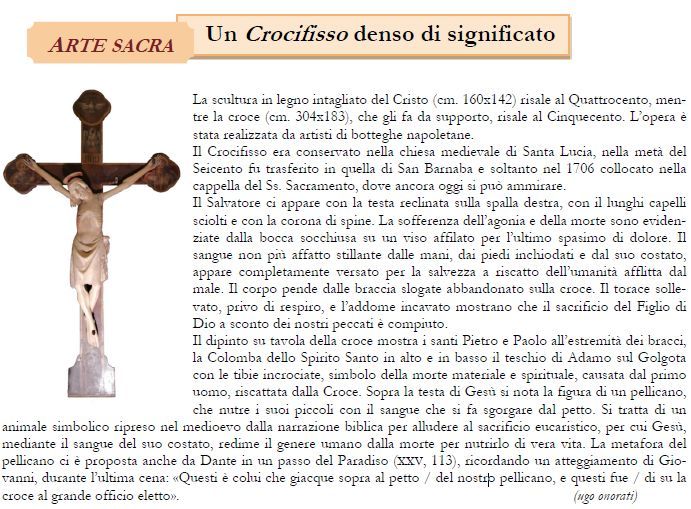

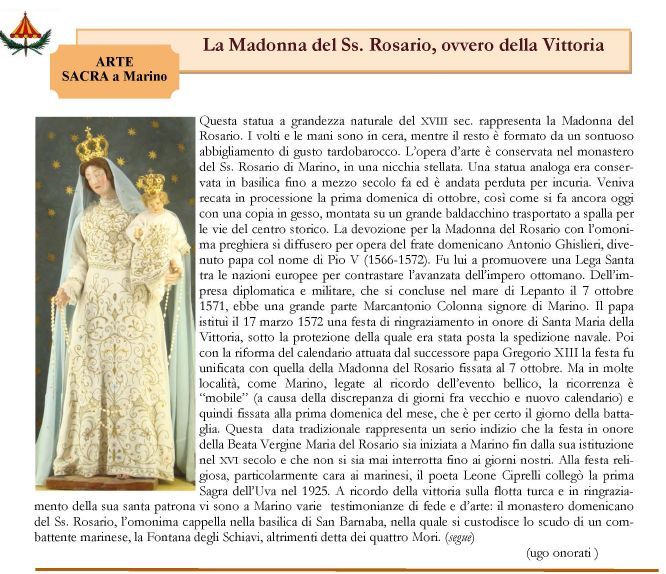
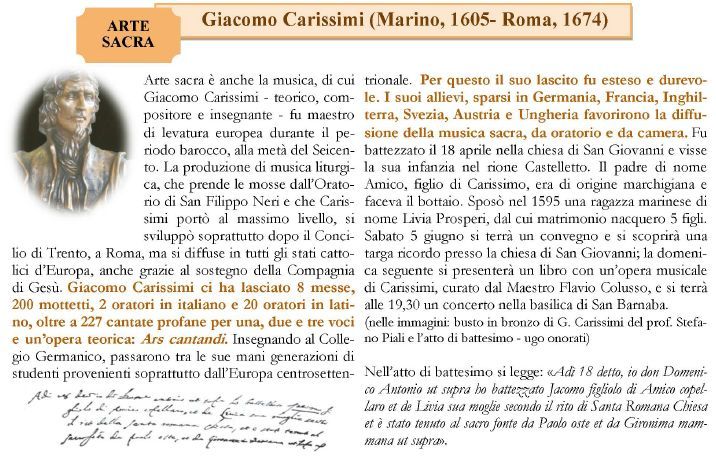
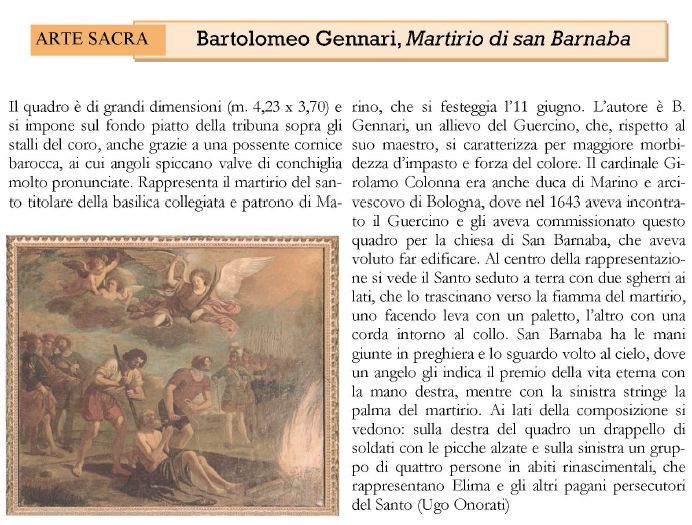
Visita la nostra basilica
Visita la nostra basilica
Visita la nostra basilica
Visita la nostra basilica
Visita la nostra basilica
Visita la nostra basilica



